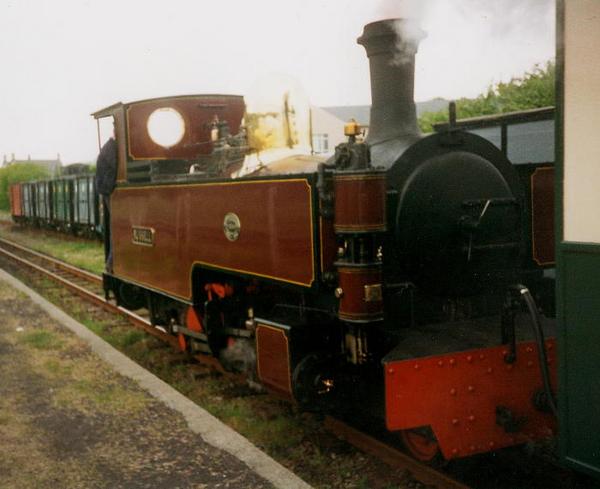- Russell (locomotive)
thumb|right|Russell_running_on_the_Welsh Highland Railway (Porthmadog) in 1995]Russell is an over 100 year old narrow gauge
steam locomotive originally built for theNorth Wales Narrow Gauge Railways (NWNGR), but most famously associated with the originalWelsh Highland Railway (WHR), and currently undergoing a rebuild at theWelsh Highland Railway (Porthmadog) .
There have been a number of books written either about, or containing details of the engine, but the succinct parts are detailed below. For further information please see [http://www.frheritage.org.uk/wiki/Russell here]History
"Russell" has a complex history.
* 1906 "Russell" was built by the
Hunslet Engine Company to the order of thePortmadoc, Beddgelert and South Snowdon Railway cite book |last=Boyd |first=James I.C. |title=Narrow Gauge Railways in South Caernarvonshire, Volume One: The Embankment Tramway, Gorseddau Tramway, Ffestiniog & Blaenau Railway, Merionethshire Railway, Croesor Tramway, Bettws-y-Coed & Ffestiniog Railway, North Wales Narrow Gauge Railways and Porthmadoc, Beedgelert & South Snowdon Railway |publisher=The Oakwood Press |year=1972] , a railway that was never completed, and was bought for the NWNGR as part of a deal for a two-year delay in electrifying its line by that Company (which still did not happen), and named after the Chairman, Managing Director and second receiver of that company.* 1922 It became the property of the WHR along with the NWNGR and the partially completed trackbed of the PBSSR cite book |title=The Slate Railways of Wales |last=Richards |first=Alun John |pages=158-159 |publisher=Gwasg Carreg Gwalch |year=2001] .
* 1924 after the WHR was taken over by the neighbouring
Ffestiniog Railway (FfR), "Russell" was reduced in height in order to allow it to work trains on the FfR. The Ffestiniog's bridges and tunnels were built to a restrictiveloading gauge . The work entailed lowering Russell's chimney, steam dome and cab; however the locomotive was still too wide and could not pass through the long Moelwyn tunnel.* 1937 the WHR closed, with "Russell" running the last through train. The locomotive was left in the sheds at Dinas cite book |last=Lee |first=Charles E. |title=Narrow-Gauge Railways in North Wales |publisher=The Railway Publishing Co. Ltd. |year=1945] .
* 1941 requisitioned for war service, refurbished by the
Brymbo Steel Works , and sent to theBrymbo Ironworks railway inOxfordshire . It was converted to a 0-6-2T after frequent derailments on the industrial tracks .* 1946 sold to
Fayle's Tramway , in theIsle of Purbeck inDorset cite book |name=Mitchell, Vic and Smith, Keith |title=Dorset & Somerset Narrow Gauge |publisher=Middleton Press |year=2006] .* 1953 commonly believed to have been laid up after breaking a driving axle...
* 1954 Russell was purchased by the Birmingham Locomotive Club for £70 in order to secure it for preservation.
* 1955 It was put on display at Tywyn Wharf station on the
Talyllyn Railway .* 1965 It was donated to the company now known as Welsh Highland Railway Limited through the generosity of the Birmingham Locomotive Club and moved to that company's base at
Kinnerley inShropshire cite book |last=Boyd |first=James I.C. |title=Narrow Gauge Railways in South Caernarvonshire, Volume Two: The Welsh Highland Railway |publisher=The Oakwoo Press |year=1989 |edition=Second Edition] .* 1970 fitted with a new boiler by its makers the
Hunslet Engine Company at Leeds and it returned to Kinnerley onJanuary 29 1971 .* 1971 sent to Lakeside Railway Estates Co. Ltd. at
Carnforth for further repairs.* 1974 moved from Carnforth to Hills & Bailey Ltd. at
Llanberis for further overhaul work . Subsequently the engine was moved to the Gelerts Farm Works of the WHR where the restoration work continued.* 1987 steamed again at the Gelerts Farm Works and has since operated trains regularly on the
Welsh Highland Railway (Porthmadog) .* 1988 and 1990 visited and operated trains on the
Ffestiniog Railway * 2000 visited the Welsh Highland Railway (Caernarfon) and operated trains on the occasion of the official reopening of the line between Dinas and Waunfawr.
* 2005 a full overhaul was begun, with the aim of running again between Porthmadog and Dinas, on the completed Welsh Highland Railway.
Design
A 2-6-2T steam locomotive, the design of Russell is more closely related to Hunslet No 865 of 1905 otherwise known as Leeds Number 1, although certain engineering aspects can be more readily associated with design of locomotives supplied to the
Sierra Leone Government Railway . One of the driving wheel centres bears the initials SLR, however this has been found to have been a later replacement and not as originally supplied. Originally built with air train brakes, it was converted to vacuum train brakes following the linking of the Welsh Highland and Ffestiniog Railways. It was fitted with air and vacuum brakes following restoration.Fiction
A character, "Fearless Freddie", based on this locomotive, appears in the children's TV series
Thomas the Tank Engine and Friends .Links
Welsh Highland Railway (Porthmadog) References
ee also
* [http://www.whr.co.uk/stock/russell Russell page on Welsh Highland Railway website]
* [http://www.russell2009.fr/ Restore Russell 2009]
* [http://www.frheritage.org.uk/wiki/Russell FR Heritage Group wiki page for Russell]
Wikimedia Foundation. 2010.

